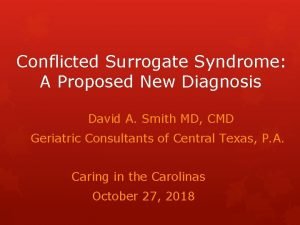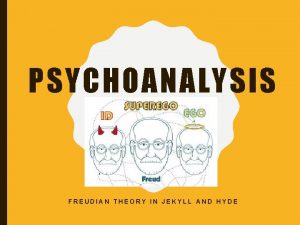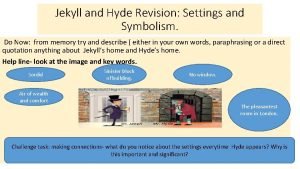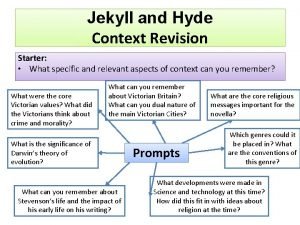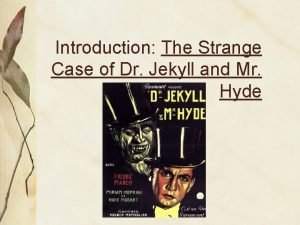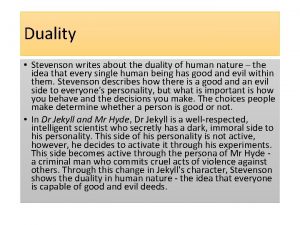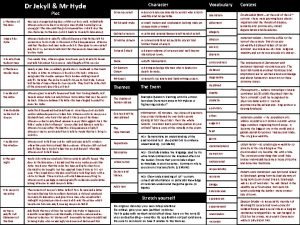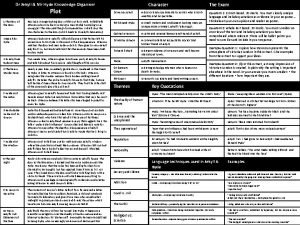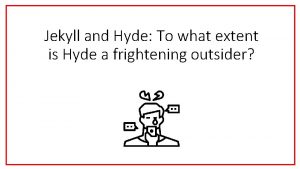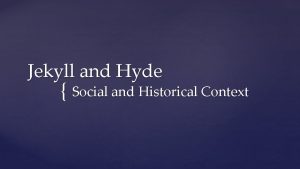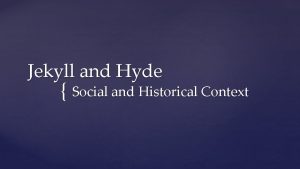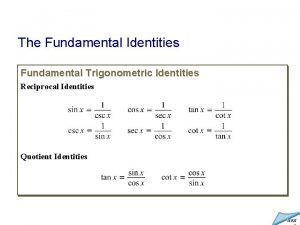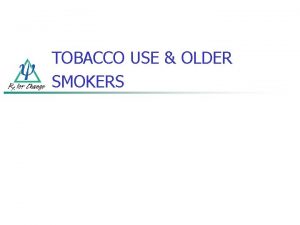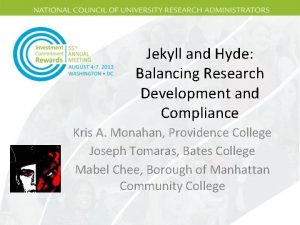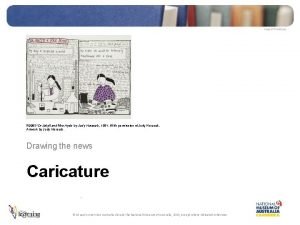Jekyll and Hyde Social Smokers Conflicted Identities Janet

















- Slides: 17

Jekyll and Hyde? Social Smokers’ Conflicted Identities Janet Hoek 1, Ninya Maubach 1, Rachel Stevenson 1, Richard Edwards 1, and Philip Gendall 2 1 University of Otago, 2 Massey University

Overview • Background – Social smoking – Social identity theory • Current study – Young adult social smokers discussing their views on tobacco use • Policy implications and conclusions

Social Smoking • Increasing intermittent smoking rates – Mainly young adults (Moran et al. 2004) – Possible risk of addiction (Di. Franza et al. 2000; Mac. Fadyen et al. 2003) – Poorer health outcomes (Schane et al. 2010) • But little knowledge about social smokers – Demographic characteristics – Reasons for social smoking – Their perceptions of smoking – Responses to cessation interventions

Contradictory Identities • Social Identity Theory (Tajfel & Turner 1979) – Social identity derived from group memberships – Motivated to follow group norms to maintain associations that are valued • Walking the tightrope: I am not a smoker, but sometimes I smoke – Non-smoking identity with superior social status – Smoking behaviour attracts stigma

Research Questions • How do young adult social smokers view and define their smoking, and reconcile conflicting smoker and non-smoker identities? • What factors facilitate or catalyse social smoking, and what measures could ameliorate these?

Method • 12 depth interviews with 18 -25 year olds who said they smoke socially – Recruited via posters, Facebook, referral – Auckland Dunedin, January 2011 • Semi-structured interview protocol – Smoking identities – Perceptions of smoking / smokers – Smoking behaviours and environments • Thematic analysis (Braun & Clarke, 2006)

Participant Demographics Gender Age Ethnicity Male Female Male Male Female NZE NZE NZE, Māori NZE NZE NZE Australian 19 19 20 25 22 21 19 19 21 24 Age Smoked First Cigarette School qualifications 16 School qualifications 14 No formal qualification 12 School qualifications 16 Certificate or diploma 12 School qualifications 15 School qualifications -Bachelor’s degree 19 School qualifications 16 Bachelor’s degree 13 School qualifications 14 Education

Results: Demarcation Strategies • Differentiation from smokers – Company: “. . . never smoke when there’s no one around. It’s only when they’re with a group of friends. Like right now they’d never go outside and have a ciggie on their own” – Control: “if you can choose when and where and how often you do something it can’t really be an addiction can it? ” – Supply: “. . . part of my rationalising, if I’m not buying them, I’m not a smoker”

Demarcation Strategies • Differentiation from smokers – Changing definition: “At the start it’s like oh I’m a social smoker and I only smoke when I drink. And then, it’s like I’m a social smoker and like I only smoke when … I’m round 4 pints, and now it’s like I’m a social smoker because I’ve never had one by myself (laughs) … for me it’s changed to always include me. ”

Alcohol as Facilitator and Excuse • Alcohol and smoking go “hand in hand” – Removes constraints: “you’re more relaxed so you don’t really mind smoking ” – Excuse: “When I’m drunk, I guess because the care factor goes down” – Cravings: “I just don’t have any cravings unless I’ve had like, if I’m out having a few drinks and then I do feel like one, but otherwise I just never feel like one”

Maintaining Social Networks • Social norm in drinking environment – Unity and cohesion: “well everyone else will be out smoking. You don’t want to sit inside on your own and just drink. . . ” – Enables conversation: “it’s not that I can’t talk without a cigarette, it’s just that something else to do all the time. It kind of makes the conversation flow a little bit more easily” – Social pressure: “Well, no one wants to smoke on their own, do they, so give me a ciggie and they’ll be like, ‘come have one with me’. . . ”

Managing Mr. Hyde • Causes severe dissonance – Resigned to circumstances: “Well I hate it. Like if someone lit one up right now I’d probably vomit. It just makes me feel so sick. It’s weird I just. . . yeah, well, after I’ve had a drink I just don’t care”. – Not at fault: “It’s a bit contradictory really because I know that it is disgusting but I guess my ability to say no sometimes is a little bit impaired”

Managing Mr. Hyde • The price to pay for group membership – “Um, physically the next day I feel like crap. Um, for the next couple of days” – “. . . it makes it all, you think ‘why did I do this? ’, you know, I don’t need to do this, this is ridiculous. But then I just do it again anyway. I dunno. It’s ridiculous, it’s absolutely ridiculous”.

Policy Option: Smokefree Outdoors • Outdoor areas strongly associated with smoking • Explored responses to suggestion of larger smokefree outdoor spaces outside bars – Would remove cues that stimulate smoking

Smokefree Outdoors • Welcomed by respondents – Eliminate pressure: “then I wouldn’t have to smoke. Like, well not have to, but none of my mates would offer me them” – Inconvenience would assert smokefree identity: “Oh, I probably wouldn’t do it if there was nobody to get cigarettes off. . . I’m willing to go outside but I’m not willing to completely leave a club to go and find someone standing somewhere on the street down the road. ”

Conclusions & Implications • A shared behaviour – Smoke to maintain group identity • Facilitated by alcohol – Remove inhibitions and concerns – Absolve from responsibility for actions • Daylight brings remorse and disgust – Challenged non-smoking identity

Conclusions & Implications • Alcohol plays a pivotal role in social smoking • Decoupling smoking from drinking environments would remove cues – Preliminary evidence for support from social smokers – Changed environment would help them maintain their preferred non-smoking identity
 Conflicted federalism definition
Conflicted federalism definition The hunger games discussion questions
The hunger games discussion questions Conflicted surrogate syndrome
Conflicted surrogate syndrome Jekyll and hyde psychoanalysis
Jekyll and hyde psychoanalysis Setting quotes jekyll and hyde
Setting quotes jekyll and hyde Jekyll and hyde key quotes
Jekyll and hyde key quotes Doktor jekyll a pan hyde rozbor
Doktor jekyll a pan hyde rozbor Symbolism in dr jekyll and mr hyde
Symbolism in dr jekyll and mr hyde Jekyll and hyde historical context
Jekyll and hyde historical context Jekyll and hyde psychology
Jekyll and hyde psychology Jekyll and hyde homosexuality quotes
Jekyll and hyde homosexuality quotes Dr. jekyll and mr. hyde plot
Dr. jekyll and mr. hyde plot Dr jekyll and mr hyde doppelganger
Dr jekyll and mr hyde doppelganger Jekyll and hyde exam questions
Jekyll and hyde exam questions Jekyll and hyde context victorian gentleman
Jekyll and hyde context victorian gentleman Knowledge organiser jekyll and hyde
Knowledge organiser jekyll and hyde Mr hyde cartoon
Mr hyde cartoon Jekyll and hyde revision
Jekyll and hyde revision


